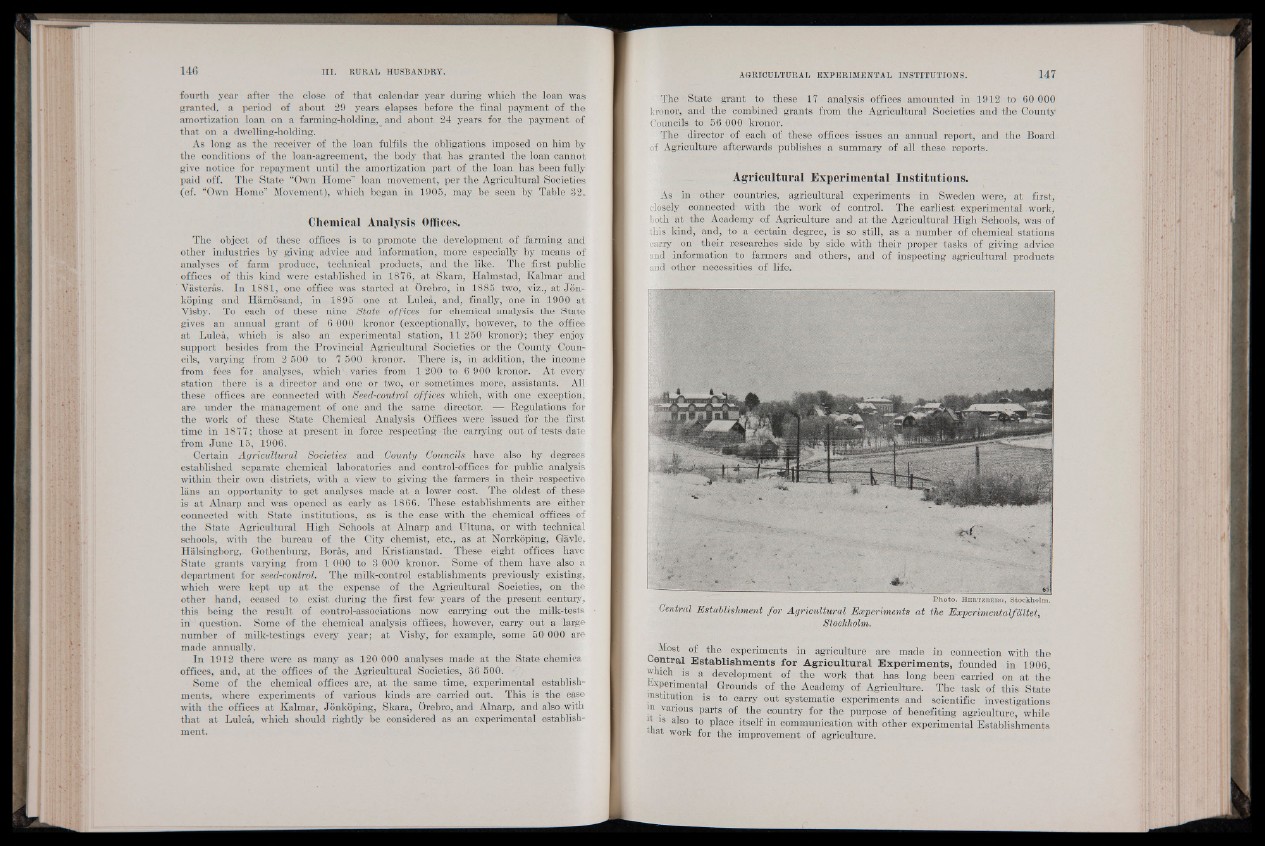
fourth year after the close of that calendar year during which the loan was
granted, a period of about 29 years elapses before the final payment of the
amortization loan on a farming-holding, and about 24 years for the payment of
that on a dwelling-holding.
As long as the receiver of the loan fulfils the obligations imposed on him by
the conditions of the loan-agreement, the body that has granted the loan cannot
give notice for repayment until the amortization part of the loan has been fully
paid off. The State “Own Home” loan movement, per the Agricultural Societies
(cf. “Own Home” Movement), which began in 1905, may be seen by Table 32.
Chemical Analysis Offices.
The object of these offices is to promote the development of farming and
other industries by giving advice and information, more especially by means of
analyses of farm produce, technical products, and the like. The first public
offices of this kind were established in 1876, at Skara, Halmstad, Kalmar and
Vàsterâs. In 1881, one office was started at Örebro, in 1885 two, viz., at Jôn-
koping and Hamosand, in 1895 one at Luleâ, and, finally, one in 1900 at
Visby. To each of these nine State offices for chemical analysis the State
gives an annual grant of 6 000 kronor (exceptionally, however, to the office
at Luleá, which is also an experimental station, 11 250 kronor); they enjoy
support besides from the Provincial Agricultural Societies or the County Councils,
varying from 2 500 to 7 500 kronor. There is, in addition, the income
from fees for analyses, which' varies from) 1 200 to 6 900 kronor. At every
station there is a director and one or two, or sometimes more, assistants. All
these offices are connected with Seed-control offices which, with one exception,
are under the management of one and the same director. — Regulations for
the work of these State Chemical Analysis Offices were issued for the first
time in 1877; those at present in force respecting the carrying out of tests date
from June 15, 1906.
Certain Agricultural Societies and County Councils have also by degrees
established separate chemical laboratories and control-offices for public analysis
within their own districts, with a view to giving the farmers in their respective
Ians an opportunity to get analyses made at a lower cost. The oldegt of these
is at Alnarp and was opened as early as 1866. These establishments are either
connected with State institutions, as is the case with the chemical offices of
the State Agricultural High Schools at Alnarp and Ultuna, or with technical
schools, with the bureau of the City chemist, etc., as at Norrkoping, Gavie,
Hàlsingborg, Gothenburg, Borâs, and Kristianstad. These eight offices have
State grants varying from 1 000 to 3 000 kronor. Some of them have also a
department for seed-control. The milk-control establishments previously existing,
which were kept up at the expense of the Agricultural Societiés, on the
other hand, ceased to exist during the first few years of the present century,
this being the result of control-associations now carrying out the milk-tests
in question. Some of the chemical analysis offices, however, carry out a large
number of milk-testings every year; at Yisby, for example, some 50 000 are
made annually.
In 1912 there were as many as 120 000 analyses made at the State chemica
offices, and, at the offices of the Agricultural Societies, 36 500.
Some of the chemical offices are, at the same time, experimental establishments,
where experiments of various kinds -are carried out. This is the case
with the offices at Kalmar, Jonkôping, Skara, Örebro, and Alnarp, and also with
that at Luleá, which should rightly be considered as an experimental establishment.
The State grant to these 17 analysis offices amounted in 1912 to 6 0 0 0 0
kronor, and the combined grants from the Agricultural Societies and the County
Councils to 56 000 kronor.
The director of each of these offices "issues an annual report, and the Board
of Agriculture afterwards publishes a summary of all these reports.
Agricultural Experimental Institutions.
As in other countries, agricultural experiments in Sweden were, • at first,
closely connected with the work of control. The earliest experimental work,
both at the Academy of Agriculture and at the Agricultural High Schools, was of
this kind, and, to a certain degree, is so still, as a number of chemical stations
carry on their researches side by side with their proper tasks of giving advice
and information to farmers and others, and of inspecting agricultural products
and other necessities of life.
Photo. Hertzbèrg, Stockholm.
Central Establishment fo r Agricultural Experiments at the Experimentalfciltet,
Stockholm.
Most of the experiments in agriculture are made in connection with the
Central Establishments for Agricultural Experiments, founded in 1906,
which is a development of the work that has long been carried on at the
Experimental Grounds of the Academy of Agriculture. The task of this State
institution is to carry out systematic experiments and scientific investigations
in various parts of the country for the purpose of benefiting agriculture, while
i is also to place itself in communication with other experimental Establishments
t work for the improvement of agriculture.